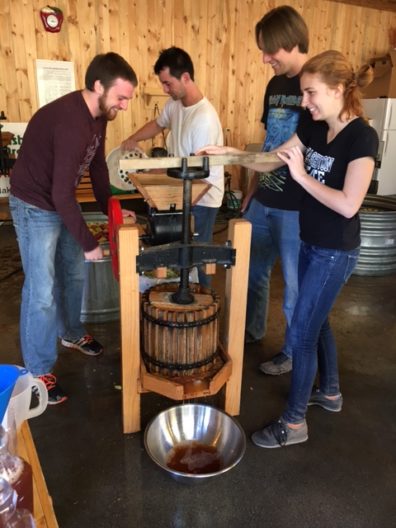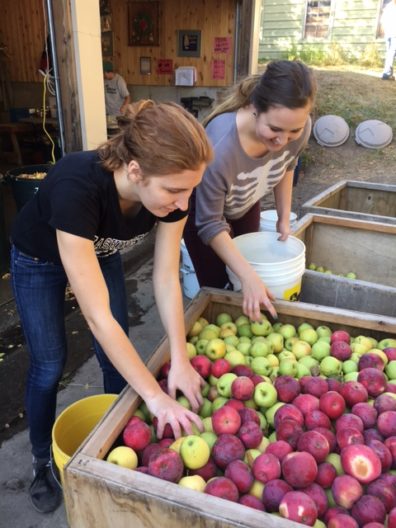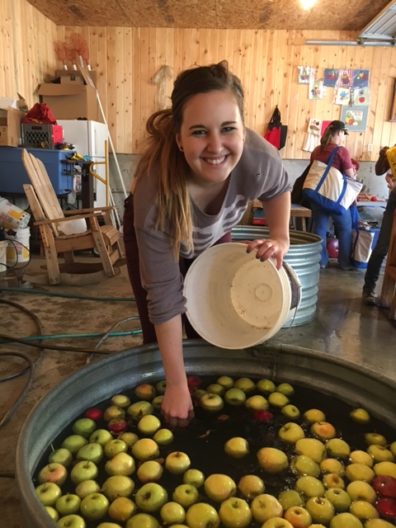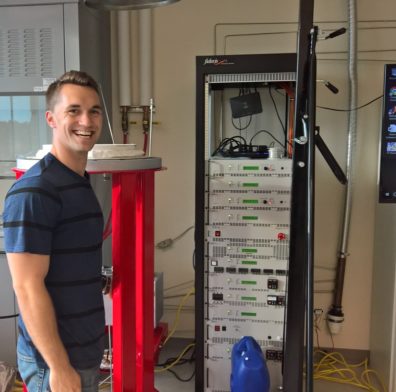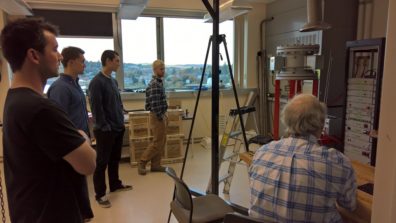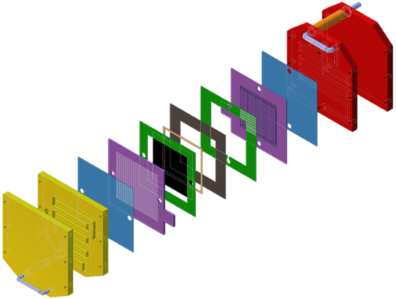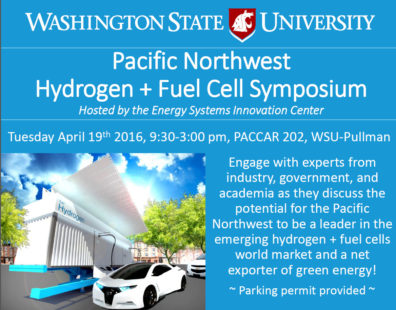Pressurized Oxygen-fed Electrochemical Test Stand (POET) is Operational!
dustin.mclartyIt’s alive! This week CESI lab fired up our pressurized SOFC test stand for the first time and received some hands on software training from Fideris/ IND. Gas lines were purged and pressure checked, and the full rated pressure was tested. Just a few more items before we can begin generating power with our SOFC. An additional burst disk will be installed on the furnace, a condensate trap on the anode exhaust line (after the pressure regulator), a new copper bus bar connection, and a 45 minute 3kW backup power supply. If all goes well preliminary testing will be underway this month. Thanks to everyone that has helped make this happen: Anomet, Aerodyne Alloys, SurfaceCoatings Inc, Jet Seal, Thermaltek, DiamondTechnologies Inc., Swagelok, and especially the WSU machine shop.
Garrett Hedberg with the newly operational test stand.
Jeff Collins, Garrett Hedberg, Austin Rapp, and Nate Royer receiving training on the new test stand control software from the great folks at Fideris / IND.
Pressurized SOFC test stand arrives
dustin.mclarty Over the past 12 months CESI lab has been designing and fabricating a custom pressurized SOFC test stand to validate the Oxy-SOFC concept. Additional details are here. Thanks to Thermaltek for designing this pressurized furnace that can operate at 1MPa and 1000C, and thanks to Fideris for helping develop this test stand that will deliver pressurized hydrogen, oxygen, and water to the SOFC test feature. We have dozens of SOFC’s to test from 4 different manufactures. Time to connect the pieces and get to testing!
Over the past 12 months CESI lab has been designing and fabricating a custom pressurized SOFC test stand to validate the Oxy-SOFC concept. Additional details are here. Thanks to Thermaltek for designing this pressurized furnace that can operate at 1MPa and 1000C, and thanks to Fideris for helping develop this test stand that will deliver pressurized hydrogen, oxygen, and water to the SOFC test feature. We have dozens of SOFC’s to test from 4 different manufactures. Time to connect the pieces and get to testing!
McLarty and Hedberg Present at ASME Fuel Cell 2016
dustin.mclartyDustin McLarty presented on the development and construction of a pressurized SOFC test stand at WSU.
Garrett Hedberg presented on a decoupled Fuel Cell Gas Turbine hybrid (dFC-GT) concept that can avoid surge/stall issues and still yield 70% fuel-to-electric efficiency.
Marshall Crenshaw awarded NASA grant
dustin.mclartyCongratulations to Marshall Crenshaw for receiving the NASA Space Grant Fellowship in Science and Engineering!
Marshall’s research into improving hydrogen liquefaction technology can reduce the energy cost of space travel and help deliver clean hydrogen fuel for fuel cell vehicles.
Keep up the great work!
Hydrogen Symposium at WSU
dustin.mclartyMany thanks to Jake Leachman and ESIC for organizing this hydrogen and fuel cell symposium yesterday, and for inviting me to speak. The symposium was a roaring success in building the momentum to bring hydrogen infrastructure to the Northwest. This beautiful Palouse Prarie has more clean power potential than anyone knows what to do with. Jump starting the northwest hydrogen economy may be the key to unlocking this potential. I’m excited to see everyone moving forward to make the Northwwest, and WSU in particular, the center of a hydrogen revolution!
The talk I gave provided an intro or Fuel Cell 101 and can be found here.
Food-Energy-Water Nexus at WSU 1-6-16
dustin.mclartyA great group of WSU faculty and staff met today to discuss strategies to address challenges in Food, Energy, and Water. While not everyone who was interested could attend here is a list of those that did, and those that have engaged in this discussion. Scientists and engineers from multiple disciplines are interested in this area, and all have something to contribute to the solution.
Click here for a summary presentation given by Dustin McLarty at today’s meeting.
Click here for a list of attendees and other faculty engaged in the FEW discussion.
Click here for a meeting summary. Thanks to Jake and Shelley for their notes
Click here for the NSF solicitation.
A google spreed sheet to expand on specific project ideas is located here.
A follow up meeting is being scheduled via Doodle.
Meeting Outcomes:
2 tracks were established for faculty to engage in food-energy-water.
Track 1: FEW as Storage-Transfer Problems
Under the assumption that optimizing storage is a key to resource resilience, and that resources are most easily extracted when in their most highly concentrated storage phase, there is a need to improve the storage capacity across all FEW sectors to meet current and future resource demand. This track focuses on the conceptualization of FEW linkages through their natural cycles to assess, and likely increase, storage capacity across the FEW system, likely through modeling. Outcomes can include identifying exiting management and physical constraints that are limiting the potential for sustainable resource use, as well as the potential for new policies and technologies to enhance natural system resilience.
Track 2: Greater Local/Regional Case Study
Select a case study (greater Pullman, the Palouse, and Columbia River Basin were discussed) to quantify and define the linkages between FEW components, including assessing unintended consequences of optimizing across a connected FEW system. The goal with this track is to identify existing technologies (or technological gaps) that have traditionally existed within individual industries, but that could be connected across sectors to actually allow for a system to be managed by linking FEW cycles.
